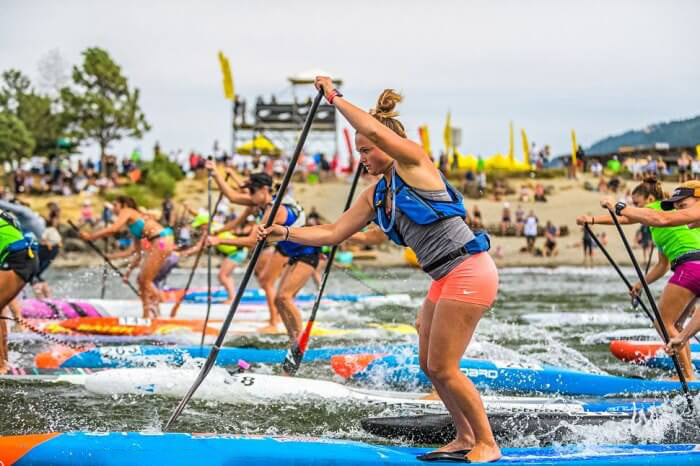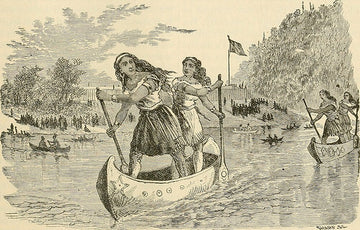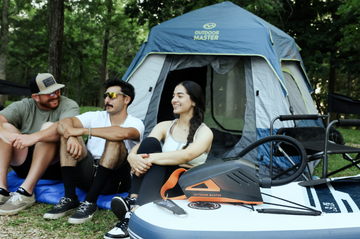
目次
スタンドアップパドルボードの歴史とは?ペルーの歴史。ポリネシアの歴史。テルアビブの歴史。イギリスの歴史。ブラジルのサーフィンの歴史。カリフォルニアのサーフィンの歴史。スタンドアップパドルボードの人気。スタンドアップ・パドル・ボーディングはサーフィンから生まれたスポーツの一種で、現代のハワイに深く根付いています。パドルボードに乗る人は、水上を自由に動くボードの上に立ち、パドルを使ってボードの動きをスムーズにします。これは、最近発明されたウォータースポーツの一つです。
このスポーツは、2013年のスポーツに関する報告書で初めて屋外スポーツの一つとして記録されました。2013年当時、このスポーツに参加していた人のほとんどはアメリカ人でした。スタンドアップパドルボードには様々な種類があり、以下の通りです。

JLFulks提供
- フラットウォーターパドリング
- レーシングパドリング
- サーフィン
- ホワイトウォータースタンドアップサーフィン
- ヨガパドリング
- 釣りパドリング
スタンドアップパドルボードの歴史は何ですか?
歴史家にとって、スタンドアップパドルがいつ始まったのかを正確に遡ることはほぼ不可能でした。SUPの起源を理解するには、まずその仕組みを理解する必要があります。
しかし、現代社会ではスポーツとして多様化しているため、スタンドアップパドルボードさえも定義することは困難です。
このアクティビティの特徴は、サーフィンのスタイル、つまり、立って漕いで進むことと、ボードを水中に進ませるためにボーダーが使用するパドルと呼ばれる長い棒を使うことだけです。
パドリングが何らかの形で何年も前から始まっていたことは、すぐに分かるでしょう。彼らは、水上船の近くに住んでいたコミュニティの古代文化を考察していました。
その歴史はアフリカから南アメリカに至る文化にまで及びます。人々はカヌーをはじめとする様々な水上船を、輸送、戦争、漁業、そして波間における娯楽に利用していました。
彼らが使っていたこれらの水上船には共通点が一つありました。それは、長い棒を使って水上船を進ませていたことです。古代、アフリカの戦士たちは丸木舟の上に立ち、槍を水に沈め、静かに漕ぎ出して敵の領土に侵入し、襲撃を仕掛けました。
ペルーの歴史

ペルーの漁師
ペルーの歴史を遡ると、約3000年前、人々はカバリトス・デ・トトラという船を使って水辺で漁をしていました。彼らはこの船を作るために葦を使っていました。これにより船の安定性が向上し、乗馬と同等の性能を持つようになりました。
彼らのパドルは、カヤックのパドルに似た長い竹の柄でした。釣りを終えると、彼らは波に乗って岸に戻り、楽しく遊びました。これがサーフィンの起源であり、スタンドアップサーフィンの発明につながったと考えられます。
ポリネシアの歴史
スタンドアップ サーフィンは世界各地で発展の歴史がありますが、現代のサーフィンは間違いなくポリネシアで始まりました。
ジェームズ・クック船長は、1778年にハワイ島へ航海し、サーフィンを目撃した最初のヨーロッパ人でした。彼らにとってサーフィンとは認識されておらず、母国語で「ヘエナル」と呼んでいました。彼らはカヌーや、コアの木で作った儀式用の道具、湾曲したボードを使っていました。
最も長いボードは、この地域の酋長が所有していたもので、長さは約5メートル。一方、村の庶民は2~3メートルのボードを使っていました。彼はパドルを使って波間を移動していました。
ハワイからは、現代のスタンドアップサーフィンの起源も辿ることができます。
1940年代、デューク・カハナモク、リロイ・アチョイ、ボビー・アチョイはワイキキでサーフィンのインストラクターをしていました。彼らはボードの上に立ち、海にいるサーファーをはっきりと見守り、遠くから波が来るのを目視していました。彼らはパドルを使ってボードを動かしながら、インストラクターとしての任務を遂行していました。後にボビー・アチョイは交通事故で負傷し、その怪我が原因で泳げなくなり、膝も動かなくなりました。
そのため、彼は常に腕にタバコをくくりつけ、首にはカメラをぶら下げ、パドルを漕ぎながら訓練生に指示を叫ばなければならなかった。ビーチボーイ・サーフィンが生まれた頃は、兄のリロイと父のジョンも自発的に立ち上がっていた。

ジェームズ・デイビス提供
1980年、イギリス人写真家ジェームズ・デイビスがハワイを訪れ、アチョイがサーフィンをしている写真を撮影しました。彼はビルダーハットとニーパッドを着用し、海に浮かぶボードの上に立っていました。これはスタンドアップ・サーフィンのスタイルでした。
その後、アチョイドはジョン・ザポトッキーにこの歴史を紹介しました。ザポトッキーはハワイにおける現代のスタンドアップサーファーの一人と言えるでしょう。ザポトッキーは1940年にハワイを訪れ、この地に魅了されました。
それ以来、彼は海があることを理由にハワイを故郷と定めました。デューク・カハナモクをはじめとするビーチボーイズからSUPを学び、サーフィンを自分のものにしました。当時の彼は、水泳、カヌーレース、パドルボード、ダイビングといったアクティビティに携わる、ごく普通のアスリートでした。
海での数々の技能を通じて、彼はビーチボーイズにとって偉大な象徴となり、「パールダイバー」という名前を与えられました。
ジョン・ザポトッキーは現在もワイキキでサーフィンを楽しんでおり、世界中の若いサーファーにとって素晴らしい象徴となっています。彼は世界最高齢のSUPサーファーであり、ハワイ全体でも最初のファーストサーファーでもあります。彼は過去60年間、ハワイのビーチにあるラックにボードを置きっぱなしにしています。サーフィン中にパドルアウトする彼は、波にとても慣れているようです。彼はワイキキビーチの若いサーファーたちに助けられ、ボードを海まで運びます。
テルアビブの歴史
SUP の発祥の地はハワイだけではありません。テルアビブにも SUP の発祥の地があり、そこではビーチのライフガードたちがハサカと呼ばれる乗り物を使って SUP をしていました。
彼らは100年前に漁師からこの技術を伝授されました。ハサケの幅は約1.5メートルです。ライフガードはそこに立ち、水面をよく見渡せるようにし、遭難者を視認できるようにします。溺死などの事故が発生した場合、ライフガードはダブルパドルを使って素早く移動し、遭難者を救助します。
その後、彼らは負傷者をボードに引き上げます。救助用に設計される前は、ボードは小型で、ライフガードは救助技術の練習をしながら波間をサーフィンするために使用していました。
英国の歴史

イースト・アングリアの湿地帯をSUPで漕ぐ男性
ここは 1886 年にイースト アングリアで初めて SUP の写真が撮影された場所だと考えられています。
その写真はイースト・アングリアの湿地帯をSUPで漕ぐ男性を写したもので、「Quantity the Marsh Hay(湿地帯の干し草の量)」と名付けられました。また、最近同じ地域で起きた出来事の一つは、デイブ・カラマがパドルを手に取り、大きなロングボードでオックスボーのシューティングゲームをしたことであり、SUPの知名度と人気が急上昇したきっかけの一つとなりました。
デイブに続いて、リック・トーマス、ブライアン・ケアウラナ、レアード・ハミルトン、アーチー・カレパも、波が下がった時のトレーニング手段としてSUPを始めました。時が経つにつれ、彼らはモロカイやオアフ島のパドルボードレースなどの大会に出場するようになりました。
ケアウラナは、マカハ ビーチの人気が高まっていることに気づき、 2003 年のバッファロー ビッグ ボード コンテストにビーチボーイ サーフィンを導入することを決意しました。
バッファロー・ビッグボード・コンテストは、当時世界中で認知されていた大会でした。その年のスタンドアップ部門には49名以上の参加者が集まり、ハワイのウォーターマンのエリートや元世界チャンピオンサーファーも含まれていました。この大会中に、あるメディアがレアード・ハミルトンの写真を撮影し、サーフィンが人々の間で大きな人気を博したのです。
ブラジルのサーフィンの歴史
ハワイアンのサーフィン写真が公開される以前、ブラジル人サーファーのオスマー・ゴンサルベスとジョアン・ロベルト・ハファースがSUPをしていた可能性が指摘されている。彼らはフリオ・プッツがデザインした「タブア・ハワイアナ」という名のボードに乗っていた。
彼らはサーフィンの先駆者と呼べるかもしれない。ただ、人々が興味を持った新しいサーフィンについて彼らの写真が出版されるという幸運には恵まれなかっただけだ。
カリフォルニアのサーフィンの歴史:現代のSUPの発明

伝統的なインドのカヌーレース
カリフォルニアにフレッチャー・バートンという名のウェーブスキーサーファーがいました。彼を現代のSUP(スタンドアップパドルボード)の発明の先駆者と呼ぶのは無理でしょう。
彼はカヤックのパドルを使って、現代のプロサーファーと同じように波に乗っていました。しかし、当時の社会は彼のサーフィンスタイルに反対するイデオロギーを持っていたため、彼は全く評価されませんでした。彼は座ったままサーフィンをしていました。座ったままサーフィンをする人は「ゴート・ボーター」と呼ばれ、差別的なレッテルを貼られましたが、彼のサーフィンスタイルは今日のプロサーファーが採用しているスタイルです。
2004年、リック・トーマスはSUPをカリフォルニアに持ち込み、温かく受け入れられました。この時点で、SUPはほぼ世界中に広まっていました。1960年代に取り残されたサーフィン業界にとって、SUPは最も重要な動きでした。
カリフォルニアでは、サーフィン用の服を着ることが当たり前になり、SUP が非常に商業化されました。サーフィンは多くの話題になりましたが、サーフィンを許されるのはほんの一握りの人だけで、それはエリートだけのものでした。
スタンドアップパドルボードの人気
アウトドア財団の報告書では、スタンドアップ・パドルボード(SUP)は初心者に最も人気のあるアウトドアスポーツの一つであると述べられており、スタンドアップ・パドルボードのプレイヤーの平均年齢は28歳であると付け加えられています。
アウトドア財団の2015年の特別報告書によると、 SUP(スタンドアップ・サーフィン)に参加しているアメリカ人は280万人で、これは人口の0.9%に相当します。これは2013年の報告書と比較して200万人増加したことになります。参加者数が最も多かったのは14歳から17歳のティーンエイジャーで、全人口の1.8%を占めています。このスポーツは男性が主流で、プレーヤーの76%が男性です。
スタンドアップパドリング競技
しかし、彼らはオリンピックの運営、規制、そして計画はISAだけが行えると主張しました。ISAは現在までに、以下の通り数々のワールドチャンピオンシップを開催してきました。

フィオナ・ワイルドは、オレゴン州フッドリバーの地元レースでスタートラインに立った。写真:ロレンゾ・メネンデス/Flux Photography
- 2012年と2013年はペルーで開催されました。
- 2014年、ニカラグアにて。
- 2015年メキシコ
- 2016年フィジー
- 2017年デンマーク
- 2018年に中国
- 2019年エルサルバドル
- 2020年のイギリス
今後数年間、スタンドアップ・パドルボード・サーフィンはさらなる発展を遂げるでしょう。このスポーツは大きな注目を集め、ファンも増え続けるでしょう。将来、SUPはサッカーのような存在になるでしょう。
ダイナミックなSUP仲間をどこで見つけたらいいかわからない方は、ぜひ私たちのSUP Facebookグループに参加してみてください。SUPコーチ、メンター、あるいはただ土曜の午後を一緒に過ごせる仲間が見つかるかもしれません。一緒にSUPを盛り上げていきましょう!
[出典: Wikipedia ]






